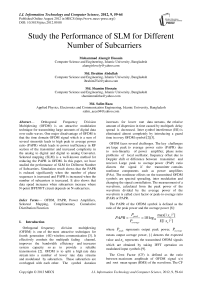Study the Performance of SLM for Different Number of Subcarriers
Автор: Mohammad Alamgir Hossain, Md. Ibrahim Abdullah, Md. Shamim Hossain, Md. Salim Raza
Журнал: International Journal of Information Technology and Computer Science(IJITCS) @ijitcs
Статья в выпуске: 9 Vol. 4, 2012 года.
Бесплатный доступ
Orthogonal Frequency Division Multiplexing (OFDM) is an attractive modulation technique for transmitting large amounts of digital data over radio waves. One major disadvantage of OFDM is that the time domain OFDM signal which is a sum of several sinusoids leads to high peak to average power ratio (PAPR) which leads to power inefficiency in RF section of the transmitter and increased complexity in the analog to digital and digital to analog Converter. Selected mapping (SLM) is a well-known method for reducing the PAPR in OFDM. In this paper, we have studied the performance of SLM for Different Number of Subcarriers. Simulation result shows that the PAPR is reduced significantly when the number of phase sequences is increased and PAPR is increased when the number of subcarriers is increased. It also shows that data speed increases when subcarriers increase where N-point IFFT/FFT circuit depends on N-subcarriers.
OFDM, PAPR, Power Amplifiers, Selected Mapping, Complimentary Cumulative Distribution Function
Короткий адрес: https://sciup.org/15011761
IDR: 15011761
Текст научной статьи Study the Performance of SLM for Different Number of Subcarriers
Published Online August 2012 in MECS
Orthogonal frequency division multiplexing (OFDM) is one of the most attractive techniques for fourth generation (4G) wireless communication [3]. It effectively combats the multipath fading channel, improves the bandwidth efficiency and increases system capacity so as to provide a reliable transmission [2]. OFDM is to split a high rate data stream into a number of lower rate data streams and modulated by subcarriers. These subcarriers are overlapped with each other. The symbol duration increases for lower rate data streams, the relative amount of dispersion in time caused by multipath delay spread is decreased. Inter symbol interference (ISI) is eliminated almost completely by introducing a guard time in every OFDM symbol [2][3].
OFDM faces several challenges. The key challenges are large peak to average power ratio (PAPR) due to non-linearity of power amplifier, phase noise problems of local oscillator, frequency offset due to Doppler shift or difference between transmitter and receiver. Large peak to average power (PAP) ratio distorts the signal if the transmitter contains nonlinear components such as power amplifiers (PAs). The nonlinear effects on the transmitted OFDM symbols are spectral spreading, inter modulation and changing the signal constellation. The measurement of a waveform, calculated from the peak power of the waveform divided by the average power of the waveform is called crest factor or peak-to-average ratio (PAR) or PAPR.
The PAPR of the OFDM symbol is defined as the ratio of the peak power and the average power [8]:
PAPR = P peak = 10log max[| xn |2]
P average 10 E [| x n | 2 ]
where P represents output peak power, P pea average means output average power, [·] denotes the expected value andx represents the transmitted OFDM signals which are obtained by taking IFFT operation on modulated input symbols [9].
The Crest Factor (CF) is defined as the ratio between maximum amplitude of OFDM signal s(t) and root mean square (RMS) of the waveform. The CF is defined as [2]:
CF ( s ( t )) = max[| s ( t ) |] = PAPR E [| s ( t ) |2]
Therefore the PAs requires a back off which is approximately equal to the PAPR for distortion less transmission. This decreases the efficiency for amplifiers. Several techniques have been proposed in the literature to reduce the PAPR [1]. These techniques can mainly be categorized in to signal scrambling techniques and signal distortion techniques. Signal scrambling techniques are all variations on how to scramble the codes to decrease the PAPR. Coding techniques can be used for signal scrambling. Golay complementary sequences, Shapiro-Rudin sequences, M sequences, Barker codes can be used efficiently to reduce the PAPR. However with the increase in the number of carriers the overhead associated with exhaustive search of the best code would increase exponentially. More practical solutions of the signal scrambling techniques are block coding, Selective Level Mapping (SLM) and Partial Transmit Sequences (PTS) [1] [4]. Signal scrambling techniques with side information reduces the effective throughput since they introduce redundancy. The signal distortion techniques introduce both in band and Out-of-band interference and complexity to the system [9]. The signal distortion techniques reduce high peaks directly by distorting the signal prior to amplification. Clipping the OFDM signal before amplification is a simple method to limit PAPR. However clipping may cause large out-of band (OOB) and in-band interference, which results in the system performance degradation. More practical solutions are peak windowing, peak cancellation, Peak power suppression, weighted multicarrier transmission, companding etc.
PAPR Reduction Techniques
Signal Scrambling Technique
Signal Distortion Technique
With Explicit Side Information
Without Explicit
Side Information
^ Signal Clipping
Coding Based
Probabilistic Schemes
Block
▲ Coding Scheme
Sub Block
Block coding
With Error Correction
a Hadamard Transform
' Method
Dummy Sequence Insertion
-
▲ Selective Level Mapping
-
▲ Partial Transmit Sequence
7 Interleaving
▲ Standard arrays of Linear Block Coding
У Tone Reservation
В Tone Injection
В Active Constellation Extension
^ Peak Windowing Envelope Scaling Random Phase Updating Peak Reduction Carrier Companding
Fig.1: PAPR Reduction Techniques
Basic requirement of practical PAPR reduction techniques include the compatibility with the family of existing modulation schemes, high spectral efficiency and low complexity. Fig. 1 shows the PAPR reduction techniques.
Signal Scrambling has the advantage that it introduces no distortion in the transmitted signal [1] and achieve significant PAPR reduction. It is suffers from data rate loss due to transmissions of several side information and need powerful channel code to protect side information. It makes the system more complex and increases the transmission delay. Other hand Signal Distortion techniques are simple, do not required extra side information. It has following disadvantages: Distortion falls in both in band and out of band. Bit Error Rate increases with increase in number of subcarriers. Out of band radiation reduces spectral efficiency [10]. In this paper, we have studied the performance of SLM for Different Number of Subcarriers in OFDM system.
The remainder of this paper is organized as follows: Section 2 OFDM technology is introduced and a basic system model of OFDM is presented. Section 3 describes the selected mapping technique (SLM) and complementary cumulative distribution function (CCDF). The simulation result and discussion are given in section 4. And finally, conclusion is drawn in Section 5.
of transmitter [5]. The starting end of receiver is a synchronizer. It is being used to equalize the received signal to prevent any channel effect and to get the proper signal.
III. Selected Mapping (SLM) Method
-
II. OFDM System Model
Fig. 2 shows the system model considered in this paper. At the starting end binary data is being inputted to the system. After that this binary data is going through to the process of digital to analog mapping. And this mapped signal is being modulated with proper modulation technique. This modulation signal is than converted into parallel signal by serial to parallel converter. This parallel data is being inputted to the IFFT operation block.
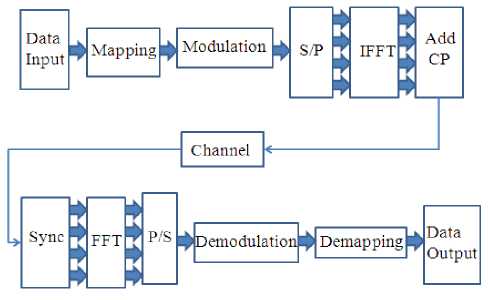
Fig. 2: OFDM transceiver block diagram
This IFFT block converts the frequency domain signal to time domain signal for each subcarrier [7]. Cyclic prefix is being added with the time domain signal. After that this time domain signal is being transmitted through the channel after proper filtering and applications [8]. This transmitted signal is received by receiver and the receiver action is somewhat inverse
The complementary cumulative distribution function (CCDF) of the original signal sequence PAPR above a threshold PAPR is written as Pr (PAPR > PAPR ) . Accordingly K statistical independent signal waveforms, CCDF can be rewritten as [{Pr(PAPR > PAPR)}]k so that the probability of PAPR that exceeds the same threshold will drop to a small value [3].
The probability of PAPR larger than a threshold z can be written as P ( PAPR > z ) = 1 - (1 - exp( - z )) N In .
the discrete time domain, an OFDM signal x of n subcarriers can be expressed as [6][8]
N - 1
-
x. = "TT i Xke*2“ / N ,0 5 n 5 N - 1 (1)
N k=0 (1)
Where, k = 0,1,2,3,...., N - 1 are input symbols modulated by BPSK or QAM and n is the discrete time index. As to the discrete time signals, since symbol-spaced sampling may sometimes miss some of the signal peaks, signal samples are obtained by oversampling by a factor of L to better approximate the true PAPR . Oversampled time-domain samples are usually obtained by LN-point IFFT of the data block with ( L - 1) N zero padding. L=4 is sufficient to capture the peaks. In the SLM approach, U statically-independent phase sequence. Fig 3 shows the block diagram of Selective Mapping (SLM) technique for PAPR reduction [6].
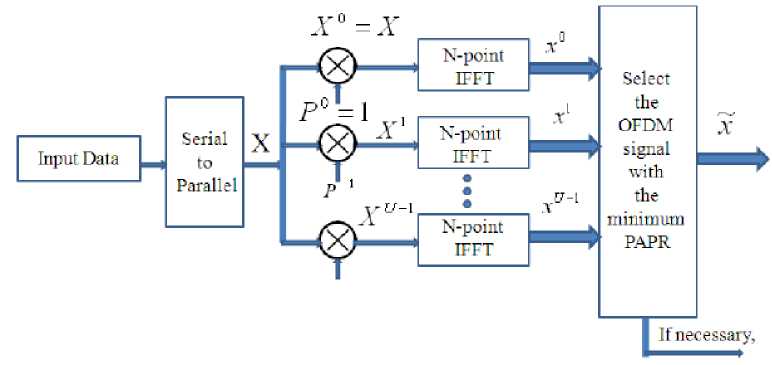
side information to transmit
Fig. 3: Block diagram of Selective Mapping (SLM) technique
Here, the input data block
X = [X|0|, X|1|,..., XN — 1 ] is multiplied with U different phase sequences p« = [puo, pu 1,..., p« n-1 ] where p = ej and
^u e [ 0,2 n ] for v = 0,1,..., N — 1
and u = 1,2,..., U , which produce a modified data block X u = [ X u 1, X u 12,..., X u| N — 1 . IFFT of
U independent sequences {Xu|v|} are taken to produce the sequences xu =[xu|0|,xu Ц,...,xu|N —1|]” , among which the one ~ = xu with the lowest is selected for transmission as shown as [6].
~ = argmin I max xu\n\ I (2)
u = 1,2,..., U V n = 0,1,..., N - 1 7
In order for the receiver to be able to recover the original data block, the information (index u ) about the selected phase sequence P u should be transmitted as side information [9]. The implementation of SLM technique requires U IFFT operations. Furthermore, it requires [ log2 U ] bits of side information for each data block where [ x ] denotes the greatest integer less than x .
-
IV. Simulation Result and Discussion
It seems that the ability of PAPR reduction using SLM is affected by the phase sequence U , number of subcarriers N and N-point FFT/IFFT circuit where N-point FFT/IFFT circuit is required to the equal number of phase sequence U. Therefore, simulation with different values of U and N and the results exhibits some desired properties of signals representing the same information. The PAPR reduction performance of the proposed scheme is examined by computer simulation with MATLAB where over sampling factor is 4 and QAM mapping is adopted as modulation scheme in each sub-carrier. Phase sequences U =1, U =4, U =8 and number of subcarriers N=32, N=64, N=128, N=256 are used. OFDM is to split a high rate data stream into a number of lower rate data streams and modulated by subcarriers.
In Fig. 4, the N=32 subcarriers are considering in this OFDM system. So 32 times bit duration increment of parallel data compare to the serial data stream. As a result inter symbol interference 32 times decreases. Hence data speed 32 times increase in this OFDM system. The complementary cumulative distribution function (CCDF) of PAPR of OFDM signals, where Selective Mapping (SLM) are used for PAPR reduction of OFDM signal and number of subcarrier 32. The
CCDF of the PAPR without SLM technique is approximately 12.2 dB where u=1 means original PAPR of OFDM signal without SLM.
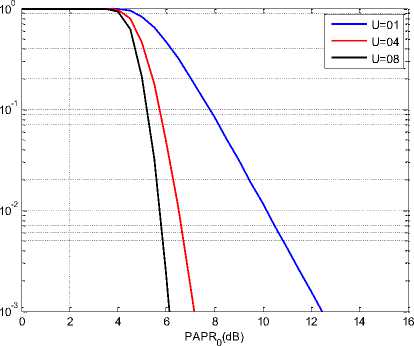
Fig. 4: PAPR performance for 32 sub carriers with AWGN channel
When u=4 then PAPR of OFDM signal is 7.2 dB. The PAPR of OFDM signal is reduced by 5 dB. Again we consider u=8 then PAPR of OFDM signal is 6.2 dB. So PAPR of OFDM signal more reduce by 6.2 dB. So it is clear that the probability of high PAPR is reduced significantly as the number of increase (U).
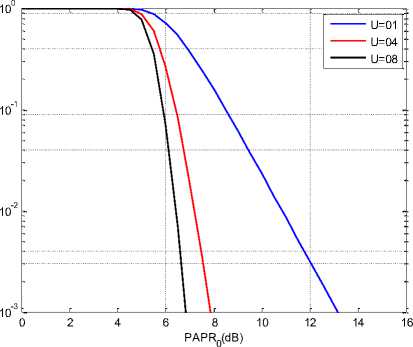
Fig. 5: PAPR performance for 64 sub carriers with AWGN channel
In Fig. 5, the N= 64 subcarriers are considering in this OFDM system. So 64 times bit duration increment of parallel data compare to the serial data stream. As a result inter symbol interference 64 times decreases. Hence data speed 64 times increase in this OFDM system. The complementary cumulative distribution function (CCDF) of PAPR of OFDM signals, where Selective Mapping (SLM) are used for PAPR reduction of OFDM signal and number of subcarrier 64 .The CCDF of the PAPR without SLM technique is approximately 13.2 dB where u=1 means original PAPR of OFDM signal without SLM. When u=4 then PAPR of OFDM signal is 7.8 dB. The PAPR of OFDM signal is reduced by 5.4 dB. Again we consider u=8 then PAPR of OFDM signal is 6.6 dB. So PAPR of OFDM signal more reduce by 6.6 dB. So it is clear that the probability of high PAPR is reduced significantly as the number of increase (U).
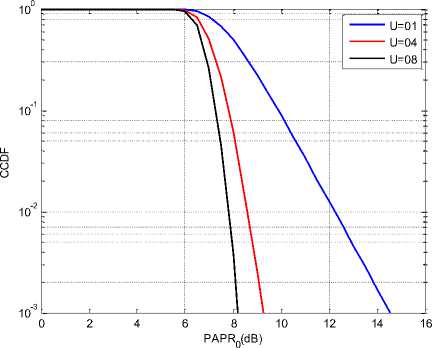
Fig. 6: PAPR performance for 128 sub carriers with AWGN channel
In Fig. 6, the N=128 subcarriers are considering in this OFDM system. So 128 times bit duration increment of parallel data compare to the serial data stream. As a result inter symbol interference 128 times decreases. Hence data speed 128 times increase in this OFDM system. The complementary cumulative distribution function (CCDF) of PAPR of OFDM signals, where Selective Mapping (SLM) are used for PAPR reduction of OFDM signal and number of subcarrier 128. The CCDF of the PAPR without SLM technique is approximately 14.6 dB where u=1 means original PAPR of OFDM signal without SLM. When u=4 then PAPR of OFDM signal is 9.2 dB. The PAPR of OFDM signal is reduced by 5.4 dB. Again we consider u=8 then PAPR of OFDM signal is 8.2 dB. So PAPR of OFDM signal more reduce by 6.4 dB. So it is clear that the probability of high PAPR is reduced significantly as the number of increase (U).
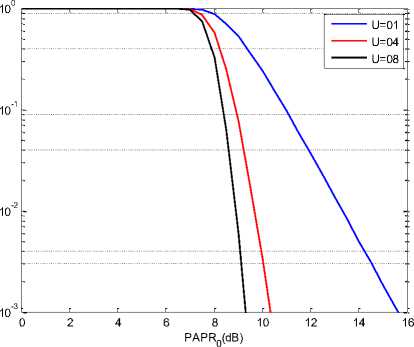
Fig. 7: PAPR performance for 256 sub carriers with AWGN channel
In Fig. 7, the N=256 subcarriers are considering in this OFDM system. So 256 times bit duration increment of parallel data compare to the serial data stream. As a result inter symbol interference 256 times decreases. Hence data speed 256 times increase in this OFDM system. The complementary cumulative distribution function (CCDF) of PAPR of OFDM signals, where Selective Mapping (SLM) Technique are used for PAPR reduction of OFDM signal and number of subcarrier 256. The CCDF of the PAPR without SLM is approximately 15.6 dB where u=1 means original PAPR of OFDM signal without SLM. When u=4 then PAPR of OFDM signal is 10.2 dB. The PAPR of OFSM signal is reduced by 5.4 dB. Again we consider u=8 then PAPR of OFDM signal is 9.2 dB. So PAPR of OFDM signal more reduce by 6.4 dB. So it is clear that the probability of high PAPR is reduced significantly as the number of increase (U).
-
V. Conclusion
In this paper, we studied the Performance of SLM for Different Number of Subcarriers. Simulation result shows that the PAPR is reduced significantly when the number of phase sequences is increased. We are clear from the above result, PAPR reduction is small difference for u=4 with compared to u=8 of selected mapping technique. When the phase sequence is increased then the number of FFT/IFFT circuit is increased in OFDM system. Implementation complexity and cost are increased. Hence u=4 means four different phase sequence are conventionally taken for SLM to reduce the PAPR of OFDM signal. The N=32, N=64, N=128 and N=256 subcarriers are considering in this OFDM system respectively with different simulation results. So 32, 64, 128 and 256 times bit duration increment of parallel data compare to the serial data stream. As a result inter symbol interference 32, 64, 128 and 256 times decreases. Hence data speed 32, 64, 128 and 256 times increase in this OFDM system. So data speed depends on different kinds of subcarriers numbers. It shows that data speed increases when subcarriers increase. But N-point IFFT/FFT circuit depends on N-subcarriers. Complex multiplications in FFT algorithm (N/2)log N depends on the number of points n. For N=32, N=64, N=128 and N=256 numbers of point’s complex multiplication are needed 80, 192, 448 and 1024 respectively. Hence when number of subcarriers N is increased, the complex multiplication in FFT is increased and when we use number of subcarriers N=128 (Fig 5) where number of phase sequence u = 4 the PAPR of OFDM signal is reduced by 5.4 dB and u=8, the PAPR of OFDM signal is reduced by 6.4 dB. Here 128-point IFFT/FFT is needed and complex multiplication is 448. So N=128 are conventionally taken for SLM.
The selected technique provides us with a good range in performance to reduce PAPR. The degradation of performance of the additional noise can be compensated by a smaller A/D-D/A quantization noise due to a reduced dynamical range through clipping. The proposed technique reduces PAPR, decrease the BER over conventional techniques, and improve the spectrum efficiency, where the proposed technique is evaluated in presence of nonlinear power amplifier. Although the some drawback is exist in the SLM. It has very high implementation complexity with high cost and side information is required. However the SLM technique is the best distortion less technique to reduce the high PAPR of OFDM signal. So high speed data transmission is possible if we used the SLM in that OFDM system.
-
[10] Y. Wu, and W.Y. Zou, “Orthogonal frequency division multiplexing: a multi-carrier modulation scheme,” IEEE Trans. on Consumer Electronics , vol. 41, no. 3, pp. 392-399, Aug. 1995.

Mohammad Alamgir Hossain received his B.SC degree with honors in Computer Science and Engineering (CSE) from Islamic University (IU), Kushtia-7003, Bangladesh, in 2010 and his M.SC degree in same department, in
2012. His current research interest is in the area of
OFDM and Cognitive Radio.
Список литературы Study the Performance of SLM for Different Number of Subcarriers
- V.Vijayarangan, DR.(MRS) R.Sukanesh, “An overview of techniques for reducing peak to average power ratio and its selection criteria for orthogonal frequency division multiplexing radio systems”, Journal of Theoretical and Applied Information Technology, pp 25-36, 2009.
- Wang Yi. Gu linfeng “An Investigation of Peak-to-Average Power Reduction in MIMO-OFDM Systems”, MSc Thesis, Blekinge Institute of Technology, Sweden, October 2009.
- R. W. Bauml, R. F. H. Fisher, and J. B. Huber, “Reducing the peak-toaverage power ratio of multicarrier modulation by selected mapping,” Electron. Lett., vol. 32, no. 22, pp. 2056–2057, Oct. 1996.
- Ramjee Prasad, “OFDM for Wireless Communications Systems”, Artech House universal personal communications series, pp 149-179, 2004.
- J. Tellado, “Peak to average power reduction for multicarrier modulation,” Ph.D. dissertation, Dept. Elect. Eng., Stanford Univ., Stanford, CA, Sep. 1999.
- Hiroshi Harada, Ramjee Prasad, "Simulation and software radio for mobile ommunications" , universal personal communications, 31 Mar 2002.
- S. H. Han, J. H. Lee, “An overview of Peak-to-Average-Power Ratio reduction techniques for multi carrier transmission”, IEEE Wireless Communication, pp.53-65, April 2005.
- X. Wang, T.T. Tjhung, and C.S. Ng, “Reduction of peak-toaverage power ratio of OFDM system using a companding technique,” IEEE Trans .on Broadcastaing, Vol. 45, No. 3, pp. 303-307, Sep. 1999.
- http://en.wikipedia.org/wiki/Orthogonal_frequency-division_multiplexing.
- Y. Wu, and W.Y. Zou, “Orthogonal frequency division multiplexing: a multi-carrier modulation scheme,” IEEE Trans. on Consumer Electronics, vol. 41, no. 3, pp. 392-399, Aug. 1995.

